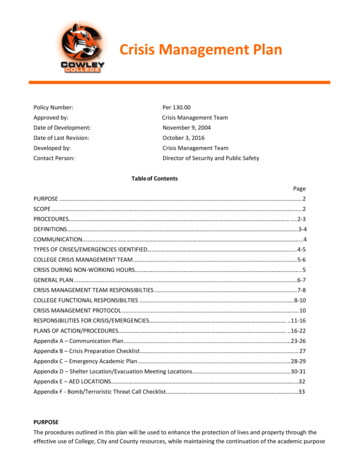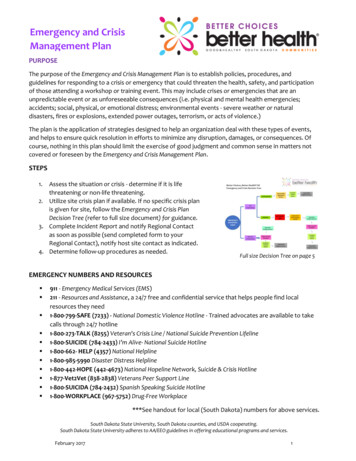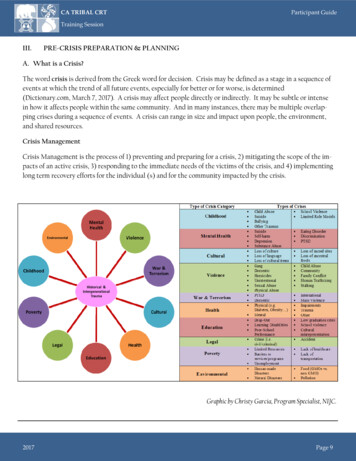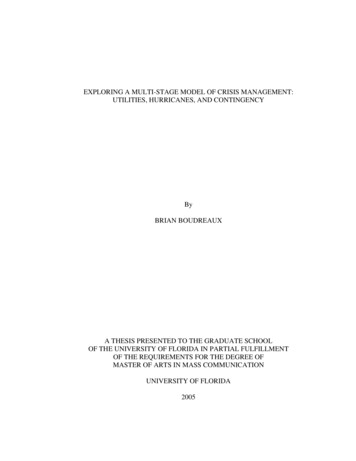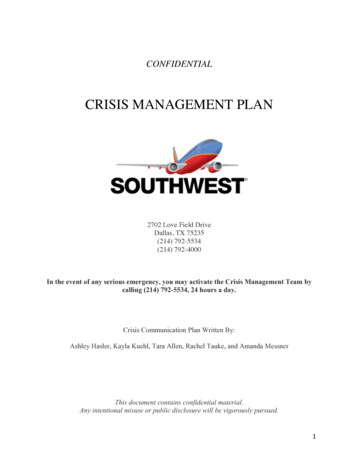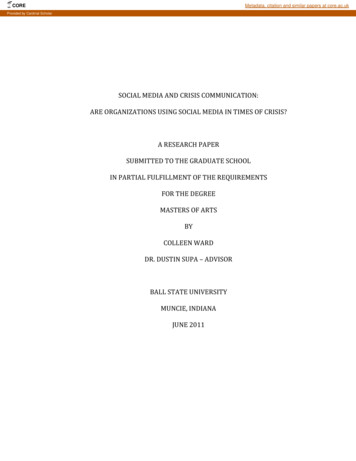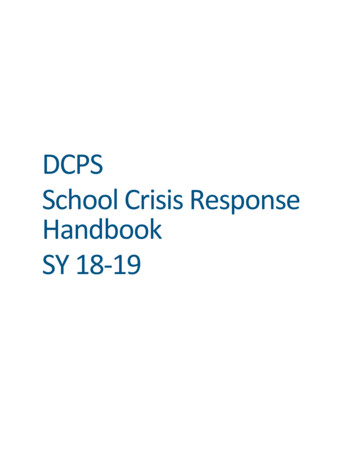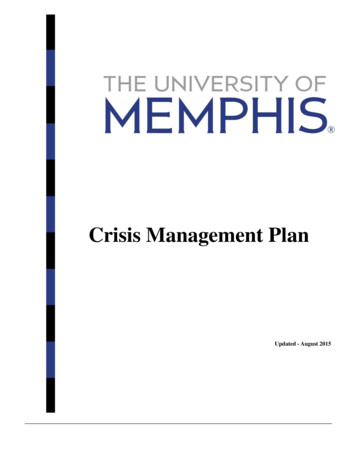
Transcription
Crisis Management PlanUpdated - August 2015
The University of MemphisCrisis Management Plan2
The University of MemphisCrisis Management PlanRecord of 303/201408/2015PagesComplete revisionAnnual reviewAnnual reviewAnnual reviewAnnual reviewAnnual reviewAnnual reviewWeb dcopyDistributionYesYesYesYesYesYesYesNOTE: This plan goes through continuous ongoing changes based on the results ofactual events, post-exercise drills and activities, and input from units and departmentstasked in this plan. The UofM will review this plan on an annual basis, but will alsomake incremental changes, modifications, and adjustments as conditions warrant. Byposting these changes on the UofM website, the most up-to-date version of this plan isinstantly available to all UofM and partner responders 24/7.A public version of this plan is available on the UofM website at:http://bf.memphis.edu/crisis/plan.phpThe full version, including checklists, contact information, and information that ismore detailed can be found at:http://bf.memphis.edu/crisis/secure/crisis mgmt plan.pdf3
The University of MemphisCrisis Management PlanRecord of DistributionDepartmentMaster CopyMaster FilesNumber of Plans1Two versions published on l: http://bf.memphis.edu/crisis/secure/crisis mgmt plan.pdfPresident3Provost2VP for Business & Finance5Chief Information Officer2VP for Marketing and Communications2VP for Student Affairs1Office of Legal Counsel2Police Services5Crisis ManagementMaster CopyEnvironmental Health and Safety4AVP Physical Plant4Network Services2Residence Life and Dining Services2Student Affairs2AVP Human Resources3Athletics1Student Disability Services1Student Health Services1Memphis-Shelby County EMA1Public Health1City of Memphis EMAParking & Transportation11Earth SciencesLambuth campus11Millington/Collierville campus24
The University of MemphisCrisis Management PlanTABLE OF CONTENTSLetter of Promulgation2Record of Revisions3Record of Distribution4Table of Contents5BASIC PLAN Introduction Purpose Planning Assumptions Plan Objectives Types and Levels of Crises Plan Activation Emergency Authority Campus Emergency Operations Center (EOC) Activation Leadership Framework for Crisis Management Response Framework for Crisis Management Crisis Management Team – Policy Group Crisis Management Team – Operations Group Crisis Management Plan – Concept of Operations Incident Command System UofM Emergency Operations Center (EOC) Priority Objectives Recovery and Planning Communications Plan Usage Plan Development, Maintenance and Dissemination Community Assistance by the ONAL ANNEXES Annex A – Emergency Support Functions Annex B – Declaration of Emergency Annex C – Crisis Communication PlanAppendix I – Communication ToolsAppendix II – Staff Contact Information Annex D – Emergency EvacuationsAssembly Area Locations Annex E – Evacuation Policy for Persons with Disabilities and Other Special Needs Annex F – Shelter In-Place Annex G – Emergency Closing Annex H – Suspicious Mail Annex I - Pandemic Preparedness and Response PlanI.1-Pandemic Flu25262931353637395760636769695
The University of MemphisCrisis Management PlanI.2-Ebola Virus Disease Annex J – ITS Disaster Recovery Plan99103HAZARD SPECIFIC APPENDICES Appendix 1 – Severe Weather including Snow and Ice Response Plan Appendix 2 – Fire/Smoke Appendix 3 – Flooding Appendix 4 – Loss of Building Utilities Appendix 5 – Bomb Threat or Explosive Device Appendix 6 – Train Derailment Appendix 7 – Demonstrations/Civil Disturbances Appendix 8 – Earthquakes Appendix 9 – Biohazard Spill Appendix 10 – Chemical Spill Appendix 11 – Environmental Spill Appendix 12 – Radiological Spill Appendix 13 – Active ENERAL APPENDICES Appendix 14 – EOC Staff Assignment Form Appendix 15 – CMT Members Contact Information- Emergency Support Functions- Satellite Phone Distribution List Appendix 16 - Guidelines for the Use and Testing of the Outdoor Warning System148149152152153154TABLES Table 1A – EOC Management Functions Table 1B – Operations Functions Table 1C – Planning Functions Table 1D – Logistics Functions Table 1E – Finance/Administration Functions156157158160161163EMERGENCY OPERATIONS CENTER ORGANIZATIONAL CHART164EMERGENCY OPERATIONS CENTER LAYOUT165CHECKLISTS Checklist 1 – Policy Group Checklist 2 – EOC Director Checklist 3 – Administration and Support Staff Checklist 4 – Internal Liaison Checklist 5 – External Liaison Checklist 6 – Public Information Officer Checklist 7 – Operations Section Chief Checklist 8 – Police Services Checklist 9 – Physical Plant Checklist 10 – Environmental Health and Safety1661671681721731741751771801821846
The University of Memphis Crisis Management PlanChecklist 11 – Animal Care FacilitiesChecklist 12 – Student Health ServicesChecklist 13 – Information TechnologyChecklist 14 – Care and ShelterChecklist 15 – Residence Life and Dining ServicesChecklist 16 – Emergency Staff ServicesChecklist 17 – CERT Team LiaisonChecklist 18 – Planning Section ChiefChecklist 19 – Situation StatusChecklist 20 – Damage AssessmentChecklist 21 – Emergency ProjectsChecklist 22 – Logistics Section ChiefChecklist 23 – Resource ProcurementChecklist 24 – Human Resources – Staff and VolunteersChecklist 25 – Site Inventory – Goods, Materials and EquipmentChecklist 26 – Transportation ServicesChecklist 27 – Emergency Food, Water and SanitationChecklist 28 – Communications/ComputingChecklist 29 – Finance/Administration Section ChiefChecklist 30 – Emergency AccountingChecklist 31 – Insurance ClaimsChecklist 32 – Employee CompensationEMERGENCY MANAGEMENT 2122132152172192212232242257
The University of MemphisCrisis Management PlanBasic Plan8
The University of MemphisCrisis Management PlanThe University of MemphisCrisis Management PlanTHE BASIC PLAN1. IntroductionThe President of The University of Memphis (UofM) has primary responsibility for effectively managingany crisis that might occur on or affect the UofM campus. Disasters or emergencies can happen suddenly,creating a situation in which normal operational and support services for the University may becomeoverwhelmed. During crises, the University requires processes that address the needs of emergency responseoperations and recovery management. To address such emergencies, the UofM hasestablished emergency response procedures, that provide guidelines for themanagement of the immediate actions and operations required to respond to anemergency or disaster. The overall priorities of the University during a disaster are theprotection of lives, valuable research, property, the community, and the environment.The overall objective is to respond to emergency conditions and manage the process ofrestoring University academic and research programs and services. This documentrepresents the Campus Crisis Management Plan, which encompasses the facilities, services andadministration of the UofM campus(es).2. Purpose of the Plan2.1 This plan provides the management structure, key responsibilities, emergency assignments, andgeneral procedures to follow during and immediately after an emergency. The University hasestablished this plan to address the immediate requirements for a major disaster or emergency inwhich normal operations are interrupted and special measures must be taken to:2.1.1Protect and preserve human life, health and well-being.2.1.2Minimize damage to the natural environment.2.1.3Minimize loss, damage or disruption to the University’s facilities, resources andoperations.2.1.4Manage immediate communications and information regarding emergency responseoperations and campus safety.2.1.5Provide essential services and operations.2.1.6Provide and analyze information to support decision-making and action plans.2.2This plan does not supersede or replace the procedures for safety, hazardous materials response orother procedures that are already in place at the University. It supplements those procedures with acrisis management structure, which provides for the immediate focus of management on responseoperations and the early transition to recovery operations.3. Planning Assumptions3.1 Emergency planning requires a commonly accepted set of assumed operational conditions thatprovide a foundation for establishing protocols and procedures. These assumptions are calledplanning assumptions, and the standard practice is to base planning on the worst-case conditions.For the University, as for all organizations in high seismic regions, the worst-case conditions are9
The University of MemphisCrisis Management Planrepresented by the earthquake hazard. Using the earthquake model, the planning assumptionsincorporated into this plan include:3.1.1Critical lifeline utilities may be interrupted, including: water delivery, electrical power,natural gas, ground-based and cellular communications, microwave and repeater basedradio systems, and information systems.3.1.2Regional and local public services may not be available.3.1.3Major roads, overpasses, bridges and local streets may be damaged.3.1.4Buildings and structures, including homes, may be damaged.3.1.5Damage and shaking may cause injuries to, and displacement of people.3.1.6Normal suppliers may not be able to deliver materials.3.1.7Contact with family and homes may be interrupted.3.1.8People may become confined to the University – as off-campus travel conditions maybecome unsafe.3.1.9Initially, the University will need to conduct its own rapid damage assessment, situationalanalysis and deployment of on-site resources and management of emergency operations,from the campus Emergency Operations Center (EOC), while emergency conditions exist.These responsibilities may change upon the arrival of emergency first responders.3.1.10.1 Communication and exchange of information will be one of the highest priority operationsat the EOC. The inter/intranets may be inoperative.4. Plan Objectives4.1 The objectives of this plan are to:4.1.1Organizationa. Provide clear and easy-to-follow checklist based guidelines for the most criticalfunctions and liaisons during an emergency response.b. Provide an easy to follow plan design in which users can quickly determine their role,responsibilities and primary tasks.c. Link and coordinate processes, actions and the exchange of critical information intoan efficient and real-time overall response so that stakeholders are informed of theemergency response process and have access to information about what is occurringat the University.4.1.2Communications and Information Managementa. Serve as the central point of communications both for receipt and transmission ofurgent information and messages.b. Serve as the official point of contact for the UofM during emergencies when normalcommunication channels are interrupted.c. Provide 24-hour communication services for voice, data and operational systems.d. Collect and collate all disaster related information for notification, publicinformation, documentation and post-incident analysis.e. Provide a basis for training staff and organizations in emergency responsemanagement.4.1.3Decision–Makinga. Determine, through a clear decision-making process, the level of response and theextent of emergency control and coordination that should be activated when incidentsoccur.4.1.4Response Operationsa. Utilize the resources at the UofM campus to implement a comprehensive andefficient emergency management response team.10
The University of MemphisCrisis Management Planb.4.1.5Be prepared with a pro-active emergency response management action plan thatprovides the possibilities and eventualities of emerging incidents.Recovery Operationsa. Transition response operations to normal management and operational processes, asable.b. Support business resumption plans and processes, as needed, during restorationphases.c. Provide documentation and information to support the Federal EmergencyManagement Agency (FEMA) disaster assistance program application.5. Types and Levels of Crisis5.1 Level 1 - Limited Crisis. A limited crisis, within the scope of this plan, is any incident, potential oractual, which will not seriously affect the overall functional capacity of the university, butnevertheless requires some degree of action. In some cases, a limited crisis may be small enoughthat the affected department can effectively resolve the issue. In other cases, assistance from theUniversity Police and/or off-campus emergency response groups may be required according to thestandard operating procedures of the UofM Police. While somedamage and/or interruption may occur, the conditions are localizedand the UofM EOC activation is not needed.Examples of Limited Crises in the context of this plan may include,but are not limited to the following: localized chemical spill,plumbing failure or water leak.5.2Level 2 - Issue-Driven Crisis. Includes issue driven and/or slowly developing situations thatnegatively impact The University of Memphis. The incident may be severe and cause damageand/or interruption to UofM operations. A partial or full activation of the UofM EOC is needed.UofM may be the only affected entity.Examples of issue driven crises may include, but are not limited to the following: unscheduled orplanned protests or disruptions; civil disturbances; unauthorized occupancy of campus areas; sexualassaults; controversial speakers; and hate crimes.5.3Level 3 - Major Crisis. A major crisis, within the scope of this plan, is an incident posing majorrisk to University personnel, students, visitors, or resources that has caused or has the potential forcausing fatalities or injuries and/or major damage. Such an incident is equivalent to a campus-wide‘state of emergency,’ and is expected to require activation of the UofM EOC and CrisisManagement Team (CMT) in order to provide an immediate emergency response. UofM mayrequest assistance from the City of Memphis, Shelby County, other State agencies or requestfederal assistance via the Memphis-Shelby County Emergency Operations Center. A Level 3 crisismay develop from incidents beginning at the Level 1 or 2 stages.Examples of major crises may include one or a combination of the following perils: active shooter,infectious disease, fire, explosion, severe weather conditions, earthquake, building collapse, flood,wind, chemical release, radioactive contamination, major civil disturbance, bomb threat, aircraftemergency, barricade or hostage situation, or other acts of terrorism.6. Plan Activation11
The University of Memphis6.1Crisis Management PlanThis plan is activated whenever emergency conditions exist in which normal operations cannot beperformed and immediate action is required to: Save and protect lives. Coordinate communications. Prevent damage to the environment, systems and property. Provide essential services. Temporarily assign University staff to perform emergency work. Invoke emergency authorization to procure and allocate resources. Activate and staff the Emergency Operations Center (EOC).7. Emergency Authority7.1 Crisis Management Team (CMT) – Policy Group7.1.1 The President of the University of Memphis serves as leader of the CMT - Policy Groupwhich may activate in the event of a Level 3 emergency or whenever executive policyissues must be addressed during a crisis. In the event of any threatened or actual disaster orcivil disorder on the campus of the University of Memphis at a time when the President ofthe University is absent from campus, the authority to take all necessary and appropriateactions on behalf of the President of the University is hereby delegated to the followingUniversity officers in the order listed below, with such authority being delegated to thehighest ranked University officer on the list whom Police Services is able to contact:1. Provost2. Chief of Staff3. Vice President for Business and Finance4. Vice President for Student Affairs5. Chief Information Officer6. Vice President for Marketing & Communications7. Vice President for AdvancementNOTE: For a civil disturbance situation only, the Director of Public Safety or, in the Director's absence,the senior on-duty police supervisor is hereby delegated the authority to take all necessary andappropriate actions on behalf of the President under the following conditions:(1) When neither the President nor any of the University officers listed above can be contacted withina reasonable period, given the immediacy and other circumstances of the threatened or actual civildisorder.(2) When an actual civil disorder is in progress and immediate action is necessary to protect personsor property from further injury or damage.7.2UofM Campus Emergency Operations Center (EOC) Activation7.2.1 During incidents and emergency conditions in which the immediate activation of the UofMEOC is needed, the following UofM positions may activate this plan and the UofM EOC,and serve as the EOC Director (in recommended order): UofM Director of Public SafetyEmergency Preparedness CoordinatorDirector of Environmental, Health and SafetyVice President for Business and Finance12
The University of MemphisCrisis Management PlanIn the event that none of the above is available, the UofM Police Services Shift Supervisor willassume authority for the activation of this plan and provide overall direction until one of the abovedesignees arrives.8. Leadership Framework for Crisis Management8.1 This leadership framework is based on the National Incident Management System (NIMS) andincorporates the Incident Command System (ICS), which is designed to provide an organizationalstructure capable of responding to various levels of emergencies ranging in complexity.It also provides the flexibility needed to respond to an incident as it escalates in severity. Becauseof this flexibility:8.28.38.48.1.1 The leadership framework for crisis management as defined in this plan does not resemblethe day-to-day organizational structure of the University. Employees may report to otheremployees to whom they do not usually have a reporting relationship.8.1.2 Further, assignments and reporting relationships may change as crisis conditions change.The Crisis Management Team (CMT) coordinates the campus response to, and recovery from Level2 and 3 Crises.Each member of the CMT has a designated alternate. For the purposes of this plan and its Annexes,the primary CMT member will be mentioned by position title. However, if the primary CMTmember is unavailable, his or her alternate will carry out the duties of the primary CMT member.The CMT is composed of two teams or groups – the Policy Group and the Operations Group.8.4.1 Role of Policy Group (CMT-Policy): Defines Crisis Policy Declares Campus State of Emergency Approves overall priorities & strategies Communicates with TBR, THEC, State Legislators, as needed Issues public information reports & instructions Determines program closures and resumptions Plans and prioritizes long term recovery8.4.2 Role of Operations Group (CMT-Operations): Determines the scope and impact of the incident Prioritizes emergency actions Deploys and coordinates resources and equipment Communicates critical information and instructions Monitors and reevaluates conditions Coordinates with government agencies (e.g., Memphis/Shelby County, TEMA, FEMA) Implements and monitors recovery operations Response Framework for Crisis Management9.19.2Any Unpredicted Crisis or Emergency. Report any crisis or emergency immediately toUniversity of Memphis Police Services at 678-HELP (4357).Police Services Dispatch will follow a defined sequence of responses for nearly all emergencysituations:9.2.1 Dispatch police officers and make appropriate fire and/or medical rescue calls.9.2.2 Notify the Director of Public Safety or his designee according to departmental procedures.13
The University of MemphisCrisis Management Plan9.2.3 Notify Emergency Preparedness Coordinator.9.2.4 Notify the Director of Environmental Health & Safety, the Assistant Vice President ofPhysical Plant, Student Health Services, and/or Residence Life per internal procedures, asappropriate.9.2.5 If warranted, the Director of Public Safety will notify the President, the Vice President forBusiness & Finance, and/or other individuals, after crisis conditions are verified byEnvironmental Health & Safety, Physical Plant and/or Student Health Services.9.2.6 The President or designee determines whether to declare a Major Crisis and notifies theDirector of Public Safety.9.2.7 See Annex C (Crisis Communications Plan) for subsequent notification procedures. 9.3Response to a Level 1 - Limited Crisis. The impacted departments or personnel coordinatedirectly with Police Services, Emergency Preparedness, Environmental Health & Safety, ResidenceLife, or Physical Plant to resolve a Level 1 Crisis. Level 1 Crises are reported through normalchannels (Police Services for issues of public safety, Physical Plant for building issues,Telecommunications for telephone problems, etc.) and, are handled based upon establisheddepartmental practices. Level 1 Crises do not require activation of the University’s CrisisManagement Plan, although portions of the plan may be utilized (e.g., Building Evacuationprocedures).9.4Response to a Level 2 - Controversial Issue. The University’s CMT Policy Group is responsiblefor evaluating Level 2 situations on a case-by-case basis. Level 2 situations can be quite complexbecause of the varied institutional, student, and community responses that must be coordinated.Activation of all or portions of the Crisis Management Plan may be warranted.9.5Response to a Level 3 - Major Crisis9.5.1 When a Level 3 crisis is declared by the President or designee (see Section 5.3), suchdeclaration authorizes the Director of Public Safety to activate the CMT-Operations Group.9.5.2 Members of the CMT-Operations Group are notified by Police Services Dispatch.9.5.3 Members of the CMT-Policy Group are notified by the President’s Office or the Office ofthe Vice President for Business & Finance.9.5.4 When crisis conditions abate, the CMT-Policy Group and the Emergency Operations CenterDirector recommend an appropriate time to return to normal conditions.9.5.5 Prior to assembling the CMT-Operations Group, on-scene responders following the IncidentCommand System (ICS), are authorized to make essential operational decisions and tocommit resources for mitigation and control purposes. Police Services may also request helpfrom other departments on an emergency basis, including requesting reassignment of stafffrom less critical assignments.9.5.6 If a Level 3 Crisis is declared, it may become necessary to restrict access to specific areason campus to only authorized personnel. Only those designated individuals with assignedcrisis response duties will be allowed to enter an area or building affected by an incident.Access restrictions will be communicated through appropriate channels. Failure to complymay result in disciplinary or legal action.Crisis Management Team-Policy Group10.1 Members of the CMT-Policy Group are notified by the President or the Vice President forBusiness & Finance or their designees.14
The University of MemphisCrisis Management Plan10.2 Membership. The CMT-Policy Group consists of University leadership as follows: President Provost Vice President for Business and Finance Vice President for Student Affairs Chief Information Officer Vice President for Communications & Marketing Director of Athletics Legal Counsel others as needed depending on the nature of the incident10.3 Joint Information Center (JIC). A JIC is a central location for involved agencies to coordinatepublic information activities and a forum for news media representatives to receive disasterinformation. The purpose of a JIC is to maintain liaisons with the news media; provide newsreleases and other information as approved by the President; assure that official statements areissued only by those administrators authorized to issue such statements; assist in handlingtelephone inquiries from the public relative to the disaster and accredit bonafide members of thenews media operating on campus. The Vice President for Communications, Public Relations andMarketing is responsible for developing procedures related to the development of such a Center. Crisis Management Team-Operations Group11.1 Members of the CMT-Operations Group are notified by Police Services Dispatch, and followprovided instructions.11.2 When notified, members of the CMT-Operations Group will immediately report to the primaryEmergency Operations Center (EOC) located on the Park Ave. Campus in the Defense AuditBuilding.11.3 CMT-Operations Group Leadership11.3.1The Director of Public Safety is the designated EOC Director, however, the Presidentmay appoint an EOC Director as the situation requires; this individual has ultimateresponsibility for activation, oversight and termination of the Emergency OperationsCenter.11.3.2In the Director of Public Safety’s absence, the Emergency Preparedness Coordinator isan alternate EOC Director. If the situation warrants, EOC Director responsibilities may be ceded to the Directorfor Environmental Health and Safety, Vice President for Business and Finance, oranother University official as directed by the President.11.4 CMT-Operations Group Membership & Responsibilities11.4.1The EOC Director is selected based upon nature of incident; this person willcollaborate with CMT Operations Group members to provide overall strategy for theEOC. Reviews and approves overall priorities and action strategies for the emergencyresponse. Works with and supports Communication Services in the development anddelivery of messages. Coordinates and communicates as necessary with the CMT PolicyGroup and other University groups regarding the UofM Campus EOC operations andoversees response and recovery operations. Activates the EOC, leads the EOC ActionPlan, and deactivate as conditions return to normal. Has the delegated authority to act in15
The University of MemphisCrisis Management Planthe best interest of the University and the goals of emergency response and recovery, onbehalf of the CMT Policy Group during immediate response operations.11.4.2Director of Public Safety will manage Police functional operations at the EOC. Servesas the Operations Section Chief for incidents in which the police field units are theIncident Commanders. Coordinates general field assignment with the Police DepartmentCommand Center and may, as needed, communicate directly with field IncidentCommanders and units. Has the lead for the Operational Action Plan for lawenforcement, security, traffic control, evacuations, access control, and crime scenepreservation. Coordinates with the county Medical Examiner's office for incidentsinvolving fatalities. Has primary authority for establishing priority for field response andpolice resource allocation. Responsible for managing search and rescue and firesuppression, if the Memphis Fire Department is not immediately available.11.4.3Emergency Preparedness Coordinator is responsible for overall supervision ofcollecting, analyzing, and displaying situation information; preparing periodic situationreports; preparing and distributing the EOC Action Plan and facilitating the actionplanning meeting; conducting advance planning activities; providing technical supportservices to the various EOC Sections and Units, and documenting and maintaining fileson all EOC activities. Information is needed to: Understand the current situationPredict probable course of incident events Prepare alternative strategies for the incident11.4.4Director of Environmental Health and Safety will manage and coordinate theenvironmental health and safety functions of the emergency response on the UofMcampus and provide consultation for emergency response at other UofM locations. Thisincludes providing input for suspected problems with hazardous chemical, biological orradiological materials or spills, or basic public health concerns related to contaminatedwater, sewage or air contaminants. Provide consultation to assist in the assessment ofunsafe conditions. Manage and coordinate on-site hazard assessments. CoordinateHazMat contractor(s) consistent with EOC priorities. Advise and provide information toother campus departments and emergency response personnel on the safety and health ofplanned operations and responses. Provide input for the Operational Action Plan forevaluating and prioritizing response operations relative to hazardous situations, firerisks, and health and environmental risks.11.4.5Assistant Vice President for Physical Plant will have the responsibility for managingand coordinating the prioritized response and exchange of operational information forall buildings, power and water utilities, roadways, and grounds with the Work ControlCenter. Has the lead for damage assessment, repair and restoration operations for allcampus power and water utilities, facilities roadways, and grounds, and assists withemergency power and support for all field operations and the EOC. Is responsible forproviding reports from outside utilities, and transitioning emergency operations to cleanup and repair operations.16
The University of MemphisCrisis Management Plan11.4.6Designee of VP for Communications, Public Relations and Marketing Services willserve as the liaison between the Joint Information Center (JIC) and the EOC Director.Collaborating with the JIC, this individual will coordinate the needs of the outside mediaand assist the EOC in determining appropriate news releases to the public.11.4.7Director for Network and Data Center Operations maintains, op
represents the Campus Crisis Management Plan, which encompasses the facilities, services and administration of the UofM campus(es). 2. Purpose of the Plan 2.1 This plan provides the management structure, key responsibilities, emergency assignments, and general procedures to follow during and immediately after an emergency. The University has
